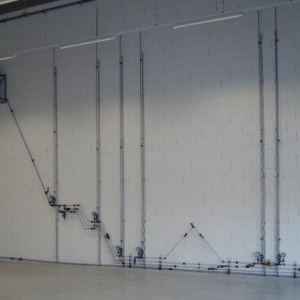
 Print / download the product sheet
Print / download the product sheetThe hydraulic channel EH1000 is a channel with variable slope, its transparent side walls allow to visualize the flow over the whole length of the vein. The design and design of the EH1000 gives it the properties of a uniform channel, ie the rigorous respect of the four Chézy conditions for the establishment of a uniform and permanent flow. The length-to-width ratio of the EH1000 classifies it as long. The water circulates in closed circuit.
The experiments include :
- Evidence of different flows: uniform, permanent, gradually or abruptly varied.
- Identification of different flow regimes: torrential, critical, fluvial
- Distribution of speeds in a channel
- Chezy, Bazin, Manning-Stricklel's formulas
- Flows above different types of thresholds: thin, thick rim, triangular weir.
- Flow measurements in a critical section
- Torrential - fluvial: the hydraulic jump
- Studies of eddy curves
- Flow through a Venturi flume and / or Parshall
- Influence of roughness on a flow
The EH1000 channel is made along its entire length in transparent Plexiglas.
Of uniform roughness, it is assembled by a special assembly which ensures parallel walls and a constant section.
The perfect rigidity of the canal is ensured by a Plexiglas box beam. At its upstream end, it rests on a manual screw jack that allows a fine adjustment of positive or negative slopes. The water is pumped from the main tank and conveyed into the canal part itself, via a "duckbill" valve, located upstream of the test vein.
The "duckbill" valve makes free flow of swirl, turbulence, vorticity and excessive disturbances.
The flow is regulated by a multi-turn manual valve and is measured by an electromagnetic needle flow meter.
The end of the canal ends with a spilling ceiling equipped with a guillotine valve from which the water falls back into the main tank. Due to its configuration, this spillway ceiling is still empty and ensures an essential hydraulic rupture at the exit of the canal.
